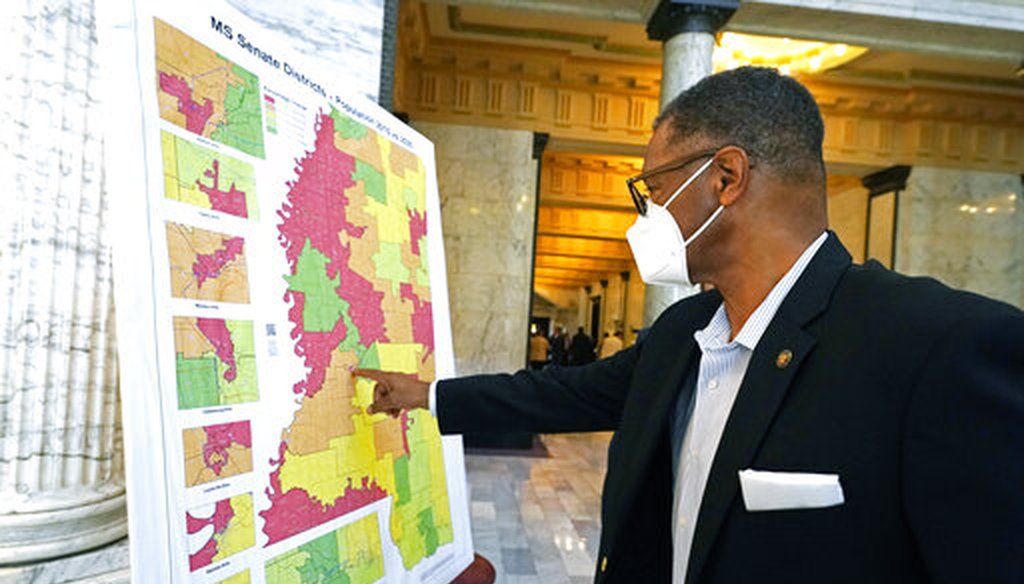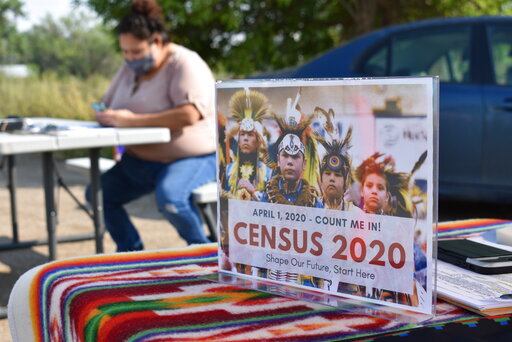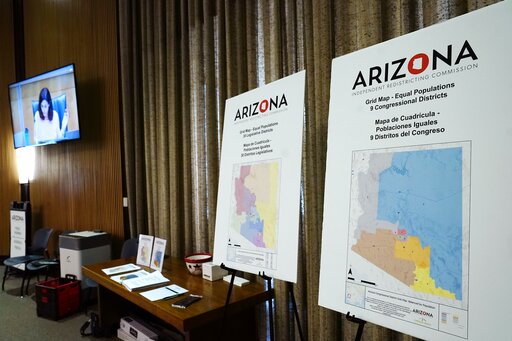Stand up for the facts!
Our only agenda is to publish the truth so you can be an informed participant in democracy.
We need your help.
I would like to contribute

Mississippi state Sen. Sollie Norwood, a Democrat, in the Capitol rotunda in Jackson on Aug. 26, 2021. The map depicts census growth or loss in each of the Mississippi Senate districts. (AP)
Across the country this year, the nation’s political maps are being redrawn. Redistricting is a complicated, even arcane process, but one with a significant impact on the nation’s political landscape. It has the potential to affect which party controls political power in the U.S. House, and has significant implications for the political power of Blacks, Latinos and other demographic groups. It also has the potential to increase political polarization across the country.
In advance of a PolitiFact/Poynter webinar on the redistricting process (more information and registration) we’re offering a rundown of how redistricting works and how it will affect ordinary voters.
Every 10 years, following the release of the Census, the lines for U.S. House seats are redrawn, as are the lines for state legislative seats.
For the U.S. House, the first step involves awarding additional seats to states that the Census has found to be gaining the most population, while subtracting seats from states found to be losing population or growing more slowly.
This shifting of seats is embedded in the Constitution; the rationale is to prevent states that have dwindling populations from exercising more political power than states with growing populations. (The Constitution does not lay out a similar process for the U.S. Senate; in that chamber, every state has two seats, regardless of population.)
This past summer, the Census Bureau announced that five states — Colorado, Florida, Montana, North Carolina, and Oregon — would gain one new seat each, while a sixth, Texas, would gain two additional seats. The bureau also announced that seven states — California, Illinois, Michigan, New York, Ohio, Pennsylvania, and West Virginia — would be losing one seat each.
Once those reapportionments were announced, each state was able to begin the process of redrawing its congressional district lines, as well as its state legislative lines.
In the states where elected legislators are tasked with drawing the new lines, the majority controls the ability to draw new lines.
Legislators can use the line-drawing process to pack voters into districts that maximize favorable outcomes for the majority party. Rather than a relatively even mix of voters in each district, it tends to produce strongly conservative districts or strongly liberal ones.
"Gerrymandering," the practice of partisan-influenced map-drawing, is common, and legal challenges to redistricting driven by partisan notices have been turned away by the Supreme Court.
The redistricting process — which will be ongoing over the next few months — could have a major impact on the shape of the U.S. House for the next 10 years.
Currently, the Democrats hold just a 220-212 lead in the House, with three vacant seats. This edge for the Democrats is small; a shift of as few as five seats could give Republicans the majority.
Every district will be redrawn over the next few months (except in Alaska, Delaware, North Dakota, South Dakota, Vermont, and Wyoming, all of which have only one seat). Just a modest tilt towards one party or the other in the current redistricting battles could make the difference between whether Democrats or Republicans end up controlling the chamber after the November 2022 midterm elections.
Before the current round of redistricting began, David Wasserman of the Cook Political Report with Amy Walter projected that, on balance, the GOP was in a position to flip three or four Democratic seats based on its ability to draw lines alone. That would be nearly enough for Republicans to take control of the chamber.
Sabato’s Crystal Ball at the University of Virginia calculated the number of "excess" House seats in each state by comparing the current balance of the state’s House delegation to the statewide results in the 2020 presidential election. Generally speaking, states with a Republican leaning overall were able to squeeze out extra seats for their party, while the opposite was true in Democratic-leaning states.
Collectively, 19 states — most of them Republican-leaning during the past decade — produced 32.4 "excess" seats for Republicans beyond their presidential performance. Meanwhile, 11 Democratic-leaning states squeezed out 28.1 "excess" seats. That’s smaller than the Republican total, but not dramatically so.
The single biggest collection of excess seats benefited the Democrats: In California, Democrats won 8.4 more seats than their statewide performance would have predicted. That was twice the number of excess seats that Texas provided for the Republicans, which was 4.3 seats.
So both parties have managed to tilt their House delegations at least modestly in their direction in the states where they hold the levers of power. And as a result, they’ve reduced the electoral clout of voters belonging to the minority party in their state, such as Democrats in Texas and Republicans in California.
Indiana State Rep. Cherrish Pryor speaks during a session at the statehouse on Sept. 23, 2021, as Republicans pushed their party's redrawing of Indiana's election districts through the chamber. (AP)
The Voting Rights Act of 1965 offers legal protection to districts with large minority populations. This makes it hard for legislators to simply eliminate heavily Black or Latino districts, or to fail to create them.
While the Voting Rights Act has been weakened by the courts in recent years, the protection for heavily minority districts remains relatively robust.
There is debate over how high the minority percentage in these districts needs to be in order to protect the rights of minority voters and the lawmakers who represent them.
In previous decades, minority lawmakers who were Democrats sometimes tolerated or even sought cooperation with Republicans to create maps in which their districts were "packed" with supermajorities of minority voters, even if that left the state’s remaining districts overwhelmingly white and Republican.
More recently, though, minority lawmakers have been reconsidering this strategy. Increasingly, minority Democratic lawmakers feel confident that they can win districts with a lower percentage of minority voters. "Unpacking" these districts, they believe, could make the surrounding districts more competitive for Democrats at large.
"As the 2022 redistricting wars heat up, multiple lawsuits aiming to unpack hyper-minority seats could help determine control of the House," Wasserman wrote recently.
Different states have different methods for drawing the lines. In some states, the public has tried to reduce the influence of legislators and gerrymandering by creating commissions to handle the task. In others, legislators still control the process.
The strongest partisan leverage can be wielded in states where one party controls both chambers of the legislature as well as the governorship. For the 2021 round of redistricting, the Republicans have a numerical advantage in seats that will be drawn this way, although the GOP’s edge is less dramatic than it was in 2011.
"The practice not so long ago of legislators preparing bipartisan redistricting plans in some states appears to have become a quaint relic," said Rich Cohen, chief author of the Almanac of American Politics.
This year, Republicans will control the remapping process in 20 states with 187 districts, according to calculations by the Cook Political Report with Amy Walter. Democrats, by contrast, will have equivalent powers in eight states with 75 districts. (As noted, six states have only a single district each.)
In the remainder of the states, full-on partisan map-drawing will be harder. In six states with 46 districts, both parties control one of the levers of powers, either a legislative chamber or the governorship. Split powers like these tend to force a compromise map.
And in 10 states with 121 districts, a bipartisan or nonpartisan commission has been tasked with drawing the lines. This mechanism also tends to promote compromises rather than fully partisan map-drawing. (See the state-by-state breakdown of redistricting power here.)
Selena Rides Horse enters census information into her phone on behalf of a member of the Crow Indian Tribe in Lodge Grass, Mont., on Aug. 26, 2020. (AP)
The 2020 Census faced steep logistical challenges due to the coronavirus pandemic. As a result, the announcement of the reapportionment results was delayed by several months.
In some states that have constitutional or statutory deadlines for finishing redistricting, the delay forced legislators to go to court seeking waivers of those deadlines. Meanwhile, in the two states that will be electing state legislators in 2021 — New Jersey and Virginia — voters were asked to choose candidates under the old districts because the new ones couldn’t be assembled in time.
Still, the impact on the redistricting process has been less drastic than some initially feared, said David Daley, a senior fellow at the election-reform group FairVote. "The Census delay slowed down the process, and has made it challenging for some states to hit deadlines, but it doesn't seem to be a major factor at this point," he said.
Majority parties in a state that want to draw a favorable map can turn to one of two strategies: locking in the status quo, or going for broke by aggressively targeting seats held by the minority party.
To lock in the status quo, a party would shore up its incumbents by protecting them from demographic change or ideological drift. The downside for the majority party is that this tends to protect the opposite party’s incumbents as well, reducing opportunities to flip additional seats in the future.
The alternative strategy is to aggressively maximize the number of seats the majority could win by drawing districts that are expected to yield narrower wins. The downside of this approach is that it can force their incumbents to play constant defense against challengers in narrowly divided districts for years to come. A gerrymander that’s too aggressive for the majority party’s own good is sometimes called a "dummymander."
In the fraction of states that have gotten far along in their redistricting process so far, "partisans are going for safety over uncertainty," Wasserman said. "Contrary to some ‘sky is falling’ claims on the left, this round is looking more like a modest GOP seat gain from redistricting, perhaps in the 0-5 seat range."
Among the maps that have been completed by now, there are signs that the dominant party has chosen a more cautious route, creating status-quo maps rather than maximizing extreme short-term gains of minority-party seats.
In Texas, for instance, the congressional map is poised to shore up districts in major metro areas that are held by Republicans who have recently seen an erosion of support among suburbanites. At the same time, the map provides safer seats for two incumbent Democrats who in 2018 flipped Republican seats.
The Texas map, as well as the one enacted in Indiana, "hypothetically could have been more aggressive in targeting current Democratic seats, but those maps are still gerrymanders that are designed to perform durably both in 2022 and beyond," said Kyle Kondik, the managing editor of Sabato's Crystal Ball, a publication of the University of Virginia Center for Politics.
The Texas map also essentially secures for the GOP a net gain of two seats, the number gained from reapportionment, despite the fact that population gains in Democratic-leaning areas drove the Census’ reallocation of two seats to Texas.
Maps like Texas’ are "still aggressive" in their own way, said Jacob Rubashkin, an analyst with the political analysis site Inside Elections. "A lot of states are already GOP gerrymanders stemming from the 2010 Republican wave election," he said. "So maps that maintain the status quo or close to it might still be considered aggressive gerrymanders."
Two Democratic-led states that have not yet completed their redistricting process — Illinois and New York — offer Democrats the same choice. While aggressive gerrymanders would be risky over the long term, they could help Democrats eat into the Republicans’ edge in national line-drawing control — and possibly spell the difference between keeping and losing the majority in 2022.
Already, in Oregon, Democrats "played hardball to pass a congressional map that gives them a healthy advantage in five of the state’s six districts," Wasserman said.
That said, it’s too early to tell where the ultimate partisan balance will lie. Several states where the GOP benefits from unfettered line-drawing powers, including Florida, Georgia, and North Carolina, have the tools to keep demographic and political shifts at bay, but they haven’t gotten far in the process yet. And in Ohio — where voters approved a ballot measure to curb gerrymandering — the GOP looks likely to follow a procedure allowed under the voter-approved measure that allows a partisan map to be enacted, but for four years rather than 10.
Legislators in some solidly Republican states are thinking about "cracking" relatively diverse and liberal metropolitan areas in order to shift Democratic voters into predominantly rural, Republican districts. This would dilute Democratic strongholds and possibly flip a seat or two to the GOP on the margins. This is a possibility for Nashville, Tenn., and Louisville, Ky., analysts said.
It’s important to note that it’s still early in the process. Only a few states with more than one U.S. House seat were able to fully enact their new U.S. House maps by late October, including Colorado, Indiana, Maine, Nebraska, Oregon, Texas, and West Virginia. Illinois has made significant progress but is not officially finished.
Even if the partisan balance in the House doesn’t change dramatically due to redistricting, the end result could still be heightened political polarization.
That’s because the more safe or nearly safe seats that are created, the more the candidates will be responsive to challengers in primaries, because it’s unlikely they would lose a general election. And since primary challenges are usually launched from the right (for Republicans) or from the left (for Democrats), both parties’ caucuses in the House could end up being even more conservative and liberal, respectively, than they are today.
"The widening urbanvs.rural chasm has increased parties' ability to draw safe seats without resorting to crazy-looking gerrymanders, so the most predictable net effect of this round is a significant decline in the number of competitive seats," Wasserman said. "When seats are in the bag, there's no incentive for parties to recruit candidates with broad appeal, and that means that fringier candidates win primaries instead."
A reduction in the number of seriously contested seats would only extend trends that have been under way for years, including a decline in split-ticket voting, Rubashkin added.
"The decline in split-ticket voting has already shrunk the House battlefield quite a bit over the last two decades, and there doesn’t seem to be much evidence that trend is reversing," Rubashkin said. The Texas map, for one, eliminated "nearly all competitive districts, so the effect is only compounded."
The Arizona Independent Redistricting Commission meets on Oct. 5, 2021, in Phoenix. Chair Erika Neuberg is seen on a monitor. (AP)
Bipartisan redistricting commissions were created in large part to dampen partisan pressures and prioritize the creation of competitive seats.
"Commissions tend to be an improvement over a purely political process," said Daley of FairVote. "They allow for public participation and greater transparency, and you almost always have ‘fairer’ maps from a partisan breakdown when all sides are at the table."
It’s still early, but analysts say they have seen some successes. In Colorado, a commission approved a compromise map fairly quickly. The map was a little more friendly to the GOP than the state’s overall partisan lean would have suggested, but it’s not far off from the state’s presidential vote breakdown. The new map features four Democratic seats, three Republican seats, and one competitive seat that would have voted for Joe Biden in 2020 by five points.
The Princeton Gerrymandering Project, which rates new map proposals on factors such as partisan fairness, geographical compactness, and avoidance of split jurisdictions, gives high marks to the commission in Arizona and is optimistic about the commission in Michigan.
However, the commission in Virginia has faced dissension. If it deadlocks, as seems likely, the map-drawing would fall to the state courts, which lean Republican despite the state’s strong turn to Democrats in recent elections.
In Ohio, the GOP-controlled legislature looks likely to sidestep elements of a voter-enacted plan to curb partisanship in redistricting. And in New York, Democrats are poised to override a commission system that voters established in the mid-2010s.
Some more partisan Democrats are quietly, or even openly, criticizing decisions by some Democratic-leaning states to turn to a commission system, saying it has robbed the party of chances to offset Republican-tilted maps in other states.
Particularly in blue-trending Colorado and Virginia, Kondik said, "Democrats are kicking themselves for helping create commissions in which Republicans will end up getting much better districts than they would have gotten if Democrats retained power."
Court battles are a virtual certainty once new maps are finalized.
Democratic challenges under the Voting Rights Act could remain potent, such as suits to prevent Black-majority districts from being over-packed. However, Republicans could parry these allegations if they are able to argue that the lines were drawn based not on racial factors but rather on other factors, such as partisanship, which is now defensible in federal court under recent Supreme Court precedent.
Meanwhile, Republicans may challenge the constitutionality of redistricting commissions. The Supreme Court blessed commissions in a 2015 decision, but the decision was 5-4, and two members of the majority, Justices Anthony Kennedy and Ruth Bader Ginsburg, have since been replaced by more conservative justices.
Finally, state supreme courts, where challenges to partisan gerrymanders may still be allowed, are likely to be a major battleground — again.
During the previous decade, courts ordered mid-decade redistricting in Florida, North Carolina, and Pennsylvania. In each of these states, a strongly Republican map was replaced by one that was more evenly balanced, and the Democratic gains they enabled helped the party take over the House in 2018. However, subsequent changes in the justices on those courts makes it unclear whether they will be as eager to overturn partisan maps this decade.
"There’s a good chance that maps in Florida, North Carolina, and Ohio will all end up before the state supreme court, all of which have been gerrymander-skeptical in recent years but have also undergone some significant personnel churn that could help Republicans," Rubashkin said.
Our Sources
Poynter Institute/PolitiFact, Redistricting and Elections webinar page, Nov. 17, 2021
Cook Political Report with Amy Walter, "Road Map to Redistricting 2021-2022," accessed Oct. 20, 2021
Cook Political Report with Amy Walter, "Redistricting Holds Key to House Majority," June 24, 2021
Sabato's Crystal Ball, "Where Both Parties Overperform in the House," July 8, 2021
U.S. News & World Report, "How the GOP May – or May Not – Take Back the House in 2022," June 10, 2021
The Atlantic, "Is It Time to Rethink Hyper-Minority Districts?" Sept. 20, 2021
FiveThirtyEight.com, "What Redistricting Looks Like In Every State," accessed Oct. 20, 2021
FiveThirtyEight.com, "How The Delayed Census Has Affected Redistricting," June 28, 2021
Princeton Gerrymandering Project, redistricting report card methodology, accessed Oct. 20, 2021
Email interview with Rich Cohen, chief author of the Almanac of American Politics 2022, Oct. 20, 2021
Email interview with David Daley, senior fellow at FairVote, Oct. 19, 2021
Email interview with Samuel Wang, director of the Princeton Gerrymandering Project, Oct. 19, 2021
Email interview with Jacob Rubashkin, analyst with Inside Elections, Oct. 19, 2021
Email interview with Kyle Kondik, managing editor of Sabato's Crystal Ball, Oct. 21, 2021
Email interview with David Wasserman, senior editor for U.S. House and redistricting at the Cook Political Report with Amy Walter, Oct. 19, 2021













































